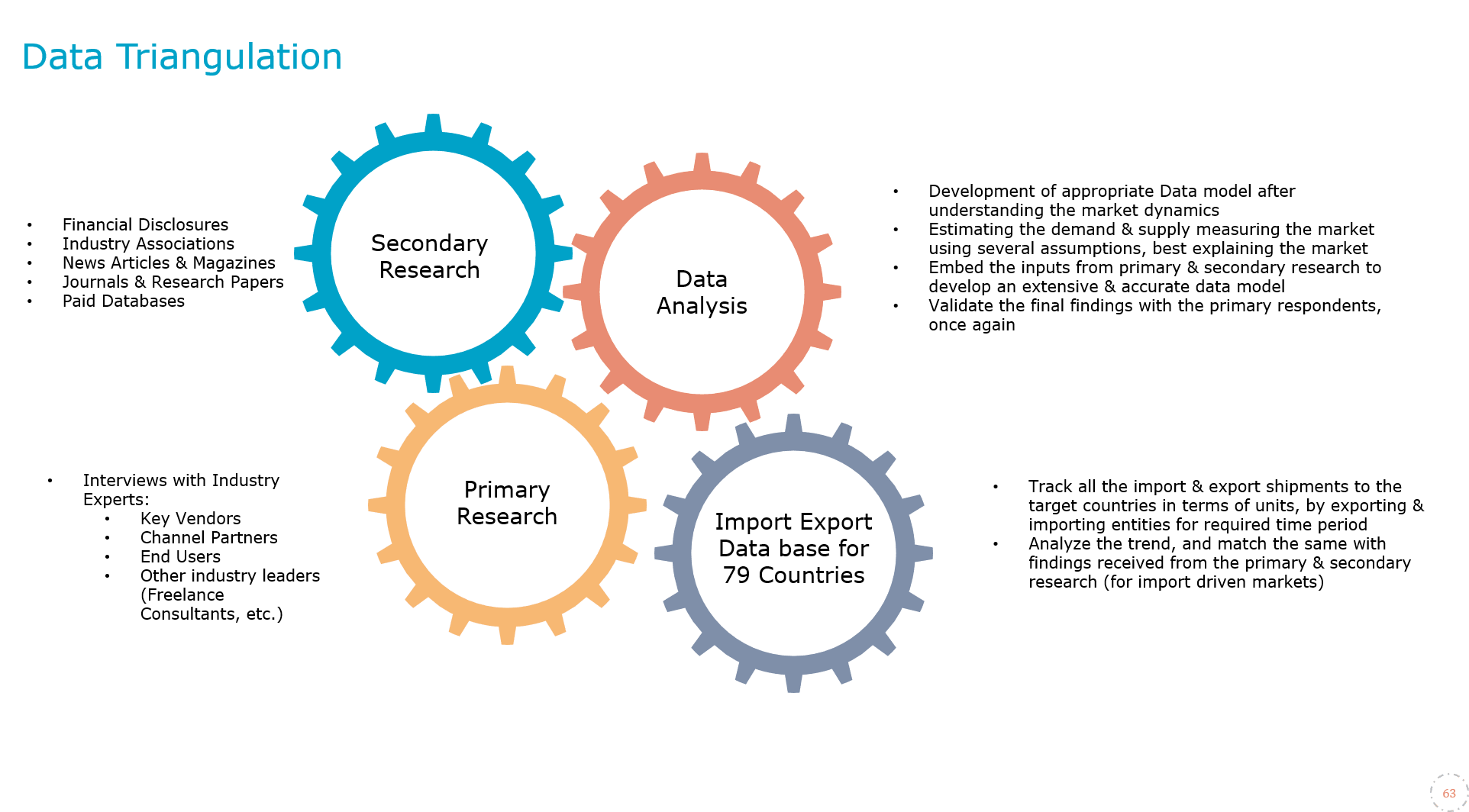
Global Seawater and Brackish Water Desalination Chemicals Market Research Report: Forecast (2023-2028)
By Source (Seawater, Brackish Water), By Chemical Type (Pre-treatment, Post-treatment), By Application (Thermal Desalination, Membrane Desalination), By Region (North America, Sout...h America, Europe, The Middle East & Africa, Asia-Pacific), By Company (Ecolab Inc., Veolia Environment S.A., Kurita Water Industries Ltd., Kemira Oyj, Calgon Carbon Corporation, Thermax Chemicals, Suez Environment S.A., Solenis LLC, Organo Chemical Industries, The Dow Chemical Company, BASF SE, AkzoNobel N.V., Lonza Group, NL Chemical Technology Inc., Buckman Laboratories, Others) Read more
- Chemicals
- Feb 2023
- Pages 194
- Report Format: PDF, Excel, PPT
Market Definition
Seawater desalination is a process in which salt & other constituents are removed to obtain pure water using various chemicals & technologies. Over 97% of the water on earth is unsuitable for human consumption due to its salinity. Thus, owing to the growing scarcity of freshwater, the need for seawater & brackish water desalination has emerged in the market.
Market Insights & Analysis: Global Seawater and Brackish Water Desalination Chemicals Market (2023-28)
The Global Seawater and Brackish Water Desalination Chemicals Market is projected to grow at a CAGR of around 8.28% during the forecast period, i.e., 2023-28, owing to the rising government initiatives for the treatment of water for reuse. The growing depletion of freshwater reserves and rising death rates & diseases among the global population due to the intake of unsafe water have been one of the prime reasons supporting the demand for desalination chemicals to treat seawater resources to ensure optimum water supply for residential & industrial needs. According to Lifewater Organization, in 2021, around 784 million populations globally have been without basic water access.
| Report Coverage | Details |
|---|---|
| Study Period | Historical Data: 2018-21 |
| Base Year: 2022 | |
| Forecast Period: 2023-28 | |
| CAGR (2023-2028) | 8.28% |
| Regions Covered | North America: US, Canada, Mexico |
| Europe: Germany, The UK, France, Spain, Italy, Rest of Europe | |
| Asia-Pacific: China, India, Japan, South Korea, Rest of Asia-Pacific | |
| South America: Brazil, Argentina, Rest of South America | |
| Middle East & Africa: UAE, Saudi Arabia, South Africa, Israel, Rest of MEA | |
| Key Companies Profiled | Ecolab Inc., Veolia Environment S.A., Kurita Water Industries Ltd., Kemira Oyj, Calgon Carbon Corporation, Thermax Chemicals, Suez Environment S.A., Solenis LLC, Organo Chemical Industries, The Dow Chemical Company, BASF SE, AkzoNobel N.V., Lonza Group, NL Chemical Technology Inc., Buckman Laboratories, Others |
| Unit Denominations | USD Million/Billion |
Hence, owing to the rising water scarcity, the government of the countries such as the US, India, the UAE, Saudi Arabia, and others has launched various initiatives to develop wastewater and seawater treatment facilities. This has further supported the demand for desalination chemicals such as pH adjusters, coagulants & flocculants, etc. Further, the continued expansion of industrial units in sectors such as chemical manufacturing, food processing, and oil & gas, among others, that make use of large quantities of seawater & brackish water to initiate production operations is also anticipated to surge the revenue growth of desalination chemicals globally.
Thus, the rising awareness of the government of various countries towards treating seawater & brackish water to minimize the growing concerns for water scarcity would continue to propel the demand for desalination chemicals, further aiding in enhancing the Global Seawater and Brackish Water Desalination Chemicals Market size during the forecast period.
.png)
Market Dynamics:
Key Trend: Growing Adoption of Hybrid Desalination Technologies for Treating Seawater & Brackish Water
The technological- & cost-related advantages associated with the deployment of desalination units using two or more processes, including thermal distillation, membrane separation, etc., are leading to a rise in the demand for hybrid desalination units globally. The enhanced energy efficiency & advantage in achieving economies of scale, flexibility, and operational security are some other factors widely affecting the deployment of hybrid desalination units. For instance:
- In 2022, ACWA Power announced a strategic partnership to develop a seawater desalination technology at the sidelines of the Saudi Water Forum to cater to the rising need for water in residential & commercial spaces.
As a result of the expanding installation of hybrid water treatment units for brackish and seawater, the country is expected to witness a strong market demand for the integration of hybrid desalination units during the forecast period.
Significant Driver: Rising Water Scarcity & Depletion of Freshwater Sources to Shoot Up the Market Growth
Earth contains nearly 2/3rd of its surface covered with water, but only 3% of the total volume has been available for drinking & agricultural purposes. The rising scarcity of freshwater on the earth, due to the growing depletion of natural resources & its rising consumption in industries, agriculture fields, and other sectors, has led to significant demand for desalination chemicals to reuse water. According to the United Nations (UN), water consumption has been increasing at 1% annually and is estimated to show a similar trend until 2050.
Therefore, to attain a sustainable approach, the government of countries like the US, the UAE, China, and others has been focusing on the development of several ways for conserving and recycling water from sea and rivers. This has widely supported the demand for various chemicals, such as chlorine, ferric chloride, etc., to desalinate wastewater & seawater.
Further, the growing support of the government of several countries to integrate residential & commercial units with desalination facilities to support water conservation is a prominent factor expected to further fuel the demand for desalination chemicals in the market. For instance:
- In 2023, the Gulf Cooperation Council announces a project for water conservation in residential buildings across the region, in which residential buildings are directly connected to a water grid that is supplied with water produced by desalination plants.
Possible Restraint: High Capital Cost & Energy Consumption Related to Seawater Desalination Units to Pose a Restraint
Seawater contains high densities of salt & other chemical compounds, which require advanced machinery & chemicals to initiate the desalination activities. As a result, the process requires a high capital cost to invest in the technology, often posing a constrain for the revenue growth of the seawater desalination chemicals market due to the unavailability of liquidity in developing countries such as Africa, Bolivia, Columbia, and Peru, etc., for developing such high-cost desalination plants that use seawater.
Additionally, as the desalination process of seawater leads to significant energy consumption & environmental pollution due to the deployment of large machinery & extraction of dense brine, the demand for seawater desalination units in countries, including Namibia, among others, is marginal.
Hence, the higher cost & low energy efficiency of seawater desalination units would continue to impact the revenue growth of the Seawater Desalination Chemicals market in the upcoming years as well.
Market Segmentation
Based on Source:
- Seawater
- Brackish Water
Brackish water source is gaining significant traction in the Global Seawater & Brackish Water Desalination market and is anticipated to witness the fastest growth rate in the upcoming years. The lower salt concentration in brackish water makes it a viable alternative water supply for municipal, industrial, and agricultural applications. As a result, agriculture-rich countries such as India, China, the US, and Brazil, among others, are progressively deploying desalination plants to treat brackish water for use in agricultural fields.
Furthermore, as a result of the government's growing support, such as flexible FDI laws, etc., the demand for adequate water resources is rising. Hence, to meet the ever-increasing demand, the government & private players are investing heavily in the deployment of brackish water desalination units, which, due to their lower salinity minimize the development of rust in the machinery. For instance:
- In 2022, the Namibian Ministry of Agriculture, Water, and Land Reform initiated the operation of a hybrid brackish water desalination plant powered by hybrid renewable energy in Bethany, Namibia, to cater to the rising demand for portable water among the residents.
Thus, with the growth initiatives of the government for the installation of brackish water desalination plants for both residential & industrial spaces, the Global Seawater & Brackish Water Desalination market is expected to witness a considerable surge in revenue growth in the upcoming years.
Based on Application:
- Thermal Desalination
- Multi-stage Flash Distillation (MSF)
- Multi-effect Distillation (MED)
- Vapor Compression Distillation (VCD)
- Membrane Desalination
- Reverse Osmosis (RO)
- Electrodialysis (ED)
- Electrodialysis reversal (EDR)
Here, Membrane Desalination is estimated to hold a substantial share of the Global Seawater & Brackish Water Desalination Chemicals market, and the same trend is expected to continue in the upcoming years. The cost competitiveness & efficiency of the membrane desalination process compared to the thermal distillation process are leading to their significant adoption globally.
Among the techniques involved in membrane distillation, reverse osmosis (RO) has been the most widely used membrane desalination technology, representing the major share of global desalination capacity. The growing development of more durable polymer membranes, improvement of penetration gaps, steps, and implementation of energy recovery devices in RO technology is projected to further drive the demand for water desalination chemicals in RO systems in the forthcoming period as well.
Regional Landscape
Geographically, the global market expands across:
- North America
- South America
- Europe
- The Middle East & Africa
- Asia-Pacific
Of all the regions across the globe, the Middle East & Africa acquired a significant share in the Global Seawater & Brackish Water Desalination Chemicals market. The significant stress towards rising water scarcity in the region has placed a positive influence on the development of seawater & brackish water desalination plants in the region, which has led to a strong demand for desalination chemicals.
Additionally, with the growing population of expatriates & rapid industrialization, the water demand is surging at a significant rate in the region. For instance, according to the US-Saudi Business Council, in 2021, the need for water supply accounted for about 25.29 billion cubic meters and is anticipated to grow slightly to 25.79 billion by 2025.
Thus, the rising population has influenced the governments of the Middle East countries to enhance their spending and take necessary initiatives to develop various seawater & brackish water desalination plant. This is anticipated to support the demand for desalination chemicals in the region. For instance:
- ACCONIA, in collaboration with SEPCOIII, announced in 2022 that it has begun construction of the Jubail 3B Independent Water Project (IWP) in Saudi Arabia, which would filter over 570,000 cubic meters of water per day. The project is scheduled to be completed by 2024.
Furthermore, the continuous expansion of the service sector and industrial units in Middle Eastern countries as a result of the government's rising initiative to shift away from oil-based economic sources is predicted to raise the need for water supply. This, is anticipated to lead to the development of new desalination plants for sea & brackish water sources, thereby catering to the demand for desalination chemicals during 2023-28.
Recent Developments by Leading Companies
- 2022: Veolia Water Technologies signed an agreement with Orange Business Services to support the growth of Hubgrade, its smart digital platform, and develop innovative digital services for its customers worldwide, to optimize the technical, economic, and environmental performance of its customers' water treatment facilities.
Gain a Competitive Edge with Our Global Seawater and Brackish Water Desalination Chemicals Market Report
- Global Seawater and Brackish Water Desalination Chemicals Market Report by MarkNtel Advisors provides a detailed & thorough analysis of market size & share, growth rate, competitive landscape, and key players. This comprehensive analysis helps businesses gain a holistic understanding of the market dynamics & make informed decisions.
- This report also highlights current market trends & future projections, allowing businesses to identify emerging opportunities & potential challenges. By understanding market forecasts, companies can align their strategies & stay ahead of the competition.
- Global Seawater and Brackish Water Desalination Chemicals Market Report aids in assessing & mitigating risks associated with entering or operating in the market. By understanding market dynamics, regulatory frameworks, and potential challenges, businesses can develop strategies to minimize risks & optimize their operations.
Frequently Asked Questions
- Market Segmentation
- Introduction
- Research Process
- Assumption
- Market Definition
- Executive Summary
- Global Seawater and Brackish Water Desalination Chemicals Market Trends & Development
- Global Seawater and Brackish Water Desalination Chemicals Market Dynamics
- Growth Drivers
- Challenges
- Global Seawater and Brackish Water Desalination Chemicals Market Hotspot and Opportunities
- Global Seawater and Brackish Water Desalination Chemicals Market Supply Chain Analysis
- Global Seawater and Brackish Water Desalination Chemicals Market Policies, Regulations, and Standards
- Global Seawater and Brackish Water Desalination Chemicals Market Outlook, 2018-2028F
- Market Size and Analysis
- By Revenues (USD Million)
- By Quantity Sold (Thousand Tons)
- Market Share and Analysis
- By Source
- Seawater
- Brackish Water
- By Chemical Type
- Pre-treatment
- PH Adjusters
- Coagulants and Flocculants
- Deposit Control Agents
- Biocides
- Reducing Chemicals
- Others (Acidification, Fine Filtration, etc.)
- Post-treatment
- Chlorination
- Remineralisation Additives
- Others (Anti-corrosion additives, Brine Treatment, etc.)
- Pre-treatment
- By Application
- Thermal Desalination
- Multi-Stage Flash Distillation (MSF)
- Multi-Effect Distillation (MED)
- Vapor Compression Distillation (VCD)
- Membrane Desalination
- Reverse Osmosis (RO)
- Electro dialysis (ED)
- Electro dialysis reversal (EDR)
- Thermal Desalination
- By Region
- North America
- South America
- Europe
- The Middle East & Africa
- Asia-Pacific
- By Company
- Competition Characteristics
- Market Share & Analysis
- By Source
- Market Size and Analysis
- North America Seawater and Brackish Water Desalination Chemicals Market Outlook, 2018-2028F
- Market Size & Analysis
- By Revenues (USD Million)
- By Quantity Sold (Thousand Tons)
- Market Share and Analysis
- By Source
- By Chemical Type
- By Application
- By Country
- The US
- Canada
- Mexico
- The US Seawater and Brackish Water Desalination Chemicals Market Outlook, 2018-2028F
- Market Size & Analysis
- By Revenues (USD Million)
- By Quantity Sold (Thousand Tons)
- Market Share and Analysis
- By Source
- By Chemical Type
- Market Size & Analysis
- Canada Seawater and Brackish Water Desalination Chemicals Market Outlook, 2018-2028F
- Market Size & Analysis
- By Revenues (USD Million)
- By Quantity Sold (Thousand Tons)
- Market Share and Analysis
- By Source
- By Chemical Type
- Market Size & Analysis
- Mexico Seawater and Brackish Water Desalination Chemicals Market Outlook, 2018-2028F
- Market Size & Analysis
- By Revenues (USD Million)
- By Quantity Sold (Thousand Tons)
- Market Share and Analysis
- By Source
- By Chemical Type
- Market Size & Analysis
- Market Size & Analysis
- South America Seawater and Brackish Water Desalination Chemicals Market Outlook, 2018-2028F
- Market Size & Analysis
- By Revenues (USD Million)
- By Quantity Sold (Thousand Tons)
- Market Share and Analysis
- By Source
- By Chemical Type
- By Application
- By Country
- Brazil
- Argentina
- Rest of South America
- Brazil Seawater and Brackish Water Desalination Chemicals Market Outlook, 2018-2028F
- Market Size & Analysis
- By Revenues (USD Million)
- Market Share and Analysis
- By Source
- By Chemical Type
- Market Size & Analysis
- Argentina Seawater and Brackish Water Desalination Chemicals Market Outlook, 2018-2028F
- Market Size & Analysis
- By Revenues (USD Million)
- By Quantity Sold (Thousand Tons)
- Market Share and Analysis
- By Source
- By Chemical Type
- Market Size & Analysis
- Market Size & Analysis
- Europe Seawater and Brackish Water Desalination Chemicals Market Outlook, 2018-2028F
- Market Size & Analysis
- By Revenues (USD Million)
- By Quantity Sold (Thousand Tons)
- Market Share and Analysis
- By Source
- By Chemical Type
- By Application
- By Country
- Germany
- France
- The UK
- Spain
- Italy
- Rest of Europe
- Germany Seawater and Brackish Water Desalination Chemicals Market Outlook, 2018-2028F
- Market Size & Analysis
- By Revenues (USD Million)
- By Quantity Sold (Thousand Tons)
- Market Share and Analysis
- By Source
- By Chemical Type
- Market Size & Analysis
- France Seawater and Brackish Water Desalination Chemicals Market Outlook, 2018-2028F
- Market Size & Analysis
- By Revenues (USD Million)
- By Quantity Sold (Thousand Tons)
- Market Share and Analysis
- By Source
- By Chemical Type
- Market Size & Analysis
- The UK Seawater and Brackish Water Desalination Chemicals Market Outlook, 2018-2028F
- Market Size & Analysis
- By Revenues (USD Million)
- By Quantity Sold (Thousand Tons)
- Market Share and Analysis
- By Source
- By Chemical Type
- Market Size & Analysis
- Spain Seawater and Brackish Water Desalination Chemicals Market Outlook, 2018-2028F
- Market Size & Analysis
- By Revenues (USD Million)
- By Quantity Sold (Thousand Tons)
- Market Share and Analysis
- By Source
- By Chemical Type
- Market Size & Analysis
- Italy Seawater and Brackish Water Desalination Chemicals Market Outlook, 2018-2028F
- Market Size & Analysis
- By Revenues (USD Million)
- By Quantity Sold (Thousand Tons)
- Market Share and Analysis
- By Source
- By Chemical Type
- Market Size & Analysis
- Market Size & Analysis
- The Middle East & Africa Seawater and Brackish Water Desalination Chemicals Market Outlook, 2018-2028F
- Market Size & Analysis
- By Revenues (USD Million)
- By Quantity Sold (Thousand Tons)
- Market Share and Analysis
- By Source
- By Chemical Type
- By Application
- By Country
- The UAE
- Saudi Arabia
- Israel
- South Africa
- Rest of the Middle East & Africa
- The UAE Seawater and Brackish Water Desalination Chemicals Market Outlook, 2018-2028F
- Market Size & Analysis
- By Revenues (USD Million)
- By Quantity Sold (Thousand Tons)
- Market Share and Analysis
- By Source
- By Chemical Type
- Market Size & Analysis
- Saudi Arabia Seawater and Brackish Water Desalination Chemicals Market Outlook, 2018-2028F
- Market Size & Analysis
- By Revenues (USD Million)
- By Quantity Sold (Thousand Tons)
- Market Share and Analysis
- By Source
- By Chemical Type
- Market Size & Analysis
- Israel Seawater and Brackish Water Desalination Chemicals Market Outlook, 2018-2028F
- Market Size & Analysis
- By Revenues (USD Million)
- By Quantity Sold (Thousand Tons)
- Market Share and Analysis
- By Source
- By Chemical Type
- Market Size & Analysis
- South Africa Seawater and Brackish Water Desalination Chemicals Market Outlook, 2018-2028F
- Market Size & Analysis
- By Revenues (USD Million)
- By Quantity Sold (Thousand Tons)
- Market Share and Analysis
- By Source
- By Chemical Type
- Market Size & Analysis
- Market Size & Analysis
- Asia-Pacific Seawater and Brackish Water Desalination Chemicals Market Outlook, 2018-2028F
- Market Size & Analysis
- By Revenues (USD Million)
- By Quantity Sold (Thousand Tons)
- Market Share and Analysis
- By Source
- By Chemical Type
- By Application
- By Country
- China
- India
- Japan
- South Korea
- Rest of Asia-Pacific
- China Seawater and Brackish Water Desalination Chemicals Market Outlook, 2018-2028F
- Market Size & Analysis
- By Revenues (USD Million)
- By Quantity Sold (Thousand Tons)
- Market Share and Analysis
- By Source
- By Chemical Type
- Market Size & Analysis
- India Seawater and Brackish Water Desalination Chemicals Market Outlook, 2018-2028F
- Market Size & Analysis
- By Revenues (USD Million)
- By Quantity Sold (Thousand Tons)
- Market Share and Analysis
- By Source
- By Chemical Type
- Market Size & Analysis
- Japan Seawater and Brackish Water Desalination Chemicals Market Outlook, 2018-2028F
- Market Size & Analysis
- By Revenues (USD Million)
- By Quantity Sold (Thousand Tons)
- Market Share and Analysis
- By Source
- By Chemical Type
- Market Size & Analysis
- South Korea Seawater and Brackish Water Desalination Chemicals Market Outlook, 2018-2028F
- Market Size & Analysis
- By Revenues (USD Million)
- By Quantity Sold (Thousand Tons)
- Market Share and Analysis
- By Source
- By Chemical Type
- Market Size & Analysis
- Market Size & Analysis
- Global Seawater and Brackish Water Desalination Chemicals Market Key Strategic Imperatives for Success and Growth
- Competitive Outlook
- Competition Matrix
- Material Type Portfolio
- Brand Specialization
- Target Markets
- Target Material Types
- Research & Development
- Strategic Alliances
- Strategic Initiatives
- Company Profiles (Business Description, Material Type Segments, Business Segments, Financials, Strategic Alliances/ Partnerships, Future Plans)
- Ecolab Inc.
- Veolia Environment S.A.
- Kurita Water Industries Ltd.
- Kemira Oyj
- Calgon Carbon Corporation
- Thermax Chemicals
- Suez Environment S.A.
- Solenis LLC
- Organo Chemical Industries
- The Dow Chemical Company
- BASF SE
- AkzoNobel N.V.
- Lonza Group
- NL Chemical Technology Inc.
- Buckman Laboratories
- Others
- Competition Matrix
- Disclaimer
MarkNtel Advisors follows a robust and iterative research methodology designed to ensure maximum accuracy and minimize deviation in market estimates and forecasts. Our approach combines both bottom-up and top-down techniques to effectively segment and quantify various aspects of the market. A consistent feature across all our research reports is data triangulation, which examines the market from three distinct perspectives to validate findings. Key components of our research process include:
1. Scope & Research Design At the outset, MarkNtel Advisors define the research objectives and formulate pertinent questions. This phase involves determining the type of research—qualitative or quantitative—and designing a methodology that outlines data collection methods, target demographics, and analytical tools. They also establish timelines and budgets to ensure the research aligns with client goals.
2. Sample Selection and Data Collection In this stage, the firm identifies the target audience and determines the appropriate sample size to ensure representativeness. They employ various sampling methods, such as random or stratified sampling, based on the research objectives. Data collection is carried out using tools like surveys, interviews, and observations, ensuring the gathered data is reliable and relevant.
3. Data Analysis and Validation Once data is collected, MarkNtel Advisors undertake a rigorous analysis process. This includes cleaning the data to remove inconsistencies, employing statistical software for quantitative analysis, and thematic analysis for qualitative data. Validation steps are taken to ensure the accuracy and reliability of the findings, minimizing biases and errors.

4. Data Forecast and FinalizationThe final phase involves forecasting future market trends based on the analyzed data. MarkNtel Advisors utilize predictive modeling and time series analysis to anticipate market behaviors. The insights are then compiled into comprehensive reports, featuring visual aids like charts and graphs, and include strategic recommendations to inform client decision-making









